 [ I have an entire webinar devoted to this subject. If you are using Compressor 3.x, watch this. If you are using Compressor 4, watch this. ]
[ I have an entire webinar devoted to this subject. If you are using Compressor 3.x, watch this. If you are using Compressor 4, watch this. ]
A question I get quite frequently is how do I convert standard-definition video into high-definition video, which is a process called “up-resing,” or “up-scaling.” This article shows you how to do this using Apple Compressor 4.
There are many different ways to up-res video and I’m interested in everyone’s opinions. So, I’m writing this article for two reasons:
YOU CAN’T GET SOMETHING FROM NOTHING
Standard-definition (SD) video is one of three, very specific image sizes:
The image dimensions for SD don’t change whether the image is 4:3 or 16:9. What does change is the shape of the pixels, going from tall and thin to short and fat.
High-definition (HD) video has two specific image sizes:
There are other sizes, such as 1280 x 1080 and 1440 x 1080, which use oddly shaped pixels to achieve their image. However, for all practical purposes, HD video conforms to one of these two sizes.
Those of you who are good at arithmetic will spot the problem immediately: SD video doesn’t contain enough pixels to fill an HD image. An NTSC SD DV image contains 345,600 pixels, while a 1080 HD image contains 2,073,600. Talk about scraping too little butter over too much bread..!
What up-resing does is stretch an SD image to fill an HD frame. Your goal, in selecting a method to use, is to retain retain as much image quality as possible.
KEY PROBLEM
Here’s the key thing you need to remember: SD video, when scaled to HD size, will never look as good as material shot originally as HD. The scaled SD material will look soft, fuzzy, lack detail, and nothing can be done to make it look as good as original HD.
However, some software can make the image look better than other software.
WHAT EDITING SOFTWARE DOES
All versions of Final Cut Pro and Premier Pro (and, perhaps, Avid, but I don’t know that program as well) take SD video and enlarge it to fill the frame of an HD image. Basically, they simply scale the picture by making the pixels fatter. This technique is very fast and works great… except that it creates a very soft, fuzzy image.
If speed is crucial, scaling in the video editor is your best option. It won’t look great, but it will be very, very fast.
A BETTER WAY
Other software, such as Compressor, tries to guess what detail is missing in the lower resolution image and add it back into the scaled-up image. Whether this works well enough for your video and your project is a subjective decision that you can make after you try it. Sometimes, the answer is yes. Other times, the answer is no.
There’s no perfect solution. But, here’s something you can try.
CONVERTING USING COMPRESSOR
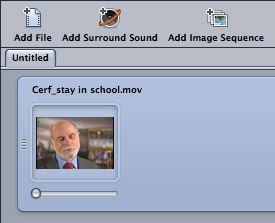
I added an NTSC 4:3 DV clip into Compressor. (Clip courtesy of Dr. Vint Cerf and Alcatel/Lucent.) Since DV is only a standard-def format, I need to do two things:
In this case, I’ll convert it to a ProRes 422 1080 clip.
NOTE: You can apply this technique to a batch of clips. You can also create a Droplet to automate the conversion. For simplicity, this article looks at up-scaling a single clip, so you can understand the process. Here’s an article that explains how to create an automated droplet.
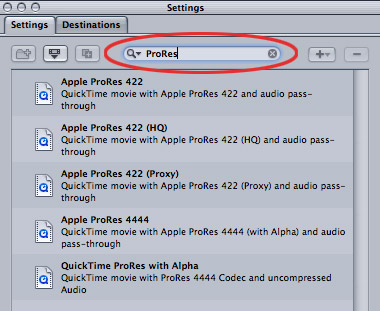
In the Settings Search box, enter ProRes; the five ProRes options are displayed. For most purposes, I find ProRes 422 to be the best all-around choice.
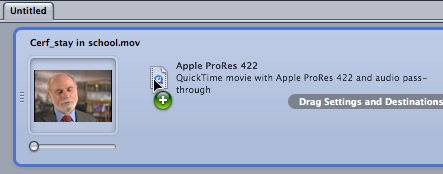
Drag the ProRes 422 setting from the Settings window and drop it on the clip in the Task window.
In the Task window, click the words “Apple ProRes 422” to display the settings applied to the clip in the Inspector.
NOTE: When creating settings in Compressor, you are always telling Compressor what you want the final image to be. Compressor will figure out what it needs to do to the Source image to achieve your final results.
THE GEOMETRY INSPECTOR

The Geometry tab in the Inspector is where we tell Compressor what size to make the image.
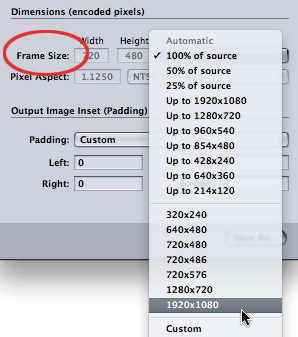
In the Dimensions section, set the Frame size to the size you want to up-res the image. In this example, I’m converting it to 1920 x 1080.
NOTE: The less you scale an image, the better it will look. So, up-resing SD video to 720 will look better than up-resing SD video to 1080.
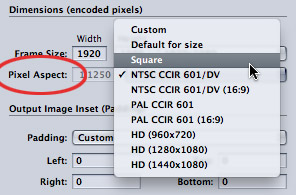
Next, set the Pixel Aspect ratio to Square. When working with HD video, Square is always the best choice. Non-square options are necessary when you are converting into a specific codec:
Unless you are converting your media into one of these special formats, always set the pixel aspect ratio to Square.
ADDITIONAL STEPS TO CONVERT 4:3 VIDEO INTO 16:9 HD
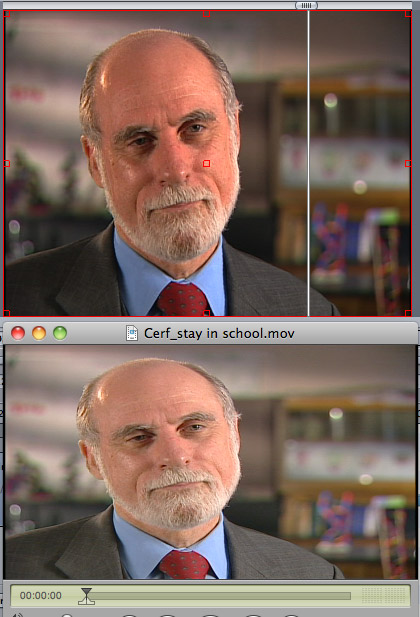
If you are converting 4:3 video into 16:9, you need to take an extra step – because if you don’t, as you can see from the screen shot above, your 4:3 video (top image) is stretched to fill a 16:9 frame (bottom image). Actors really don’t like that; as it makes them look fat.
So, we need to add padding to the left and right sides – a process called “pillar boxing” – so that the proportions of the image remain correct.
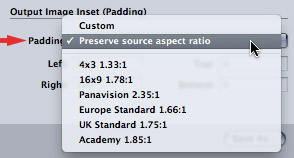
At the bottom of the Geometry section, in the Output Image section, change Padding to Preserve source aspect ratio. This adds black to the sides of the image so that the image does not get stretched.
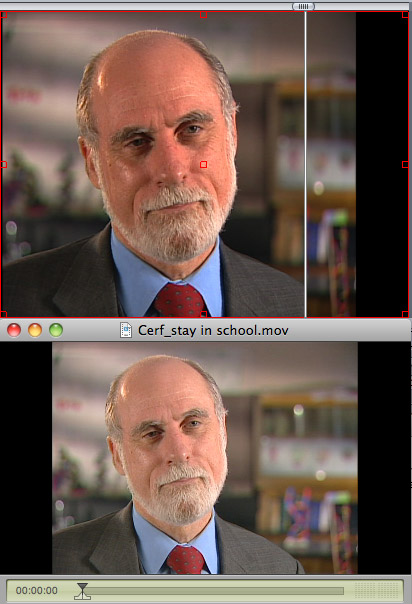
Here’s the result when padding is added. The image now looks the same as the original, but it is contained in a 16:9 frame. If, on the other hand, you don’t want the black edges, then you’ll need to crop the top and bottom of the image so that the proportions remain the same.
NOTE: You have to make a choice: black on the edges or cropping top and bottom. You can not take a 4:3 image and have it fill a 16:9 frame without either cropping or padding, unless you want it to look stretched.

To convert a 4:3 image to 16:9 by cropping, make sure all the Padding values are set to 0, then, from the Source Inset (Cropping) section, set Crop to 16:9.
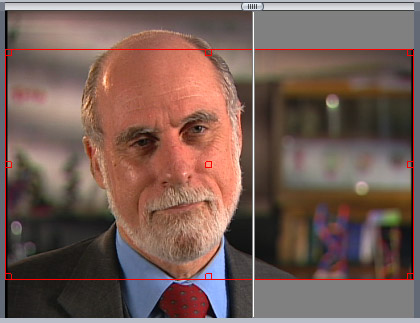
The red outline in Compressor’s Viewer illustrates the cropped image. That which is inside the red border will remain; that which is outside the red border will be discarded.
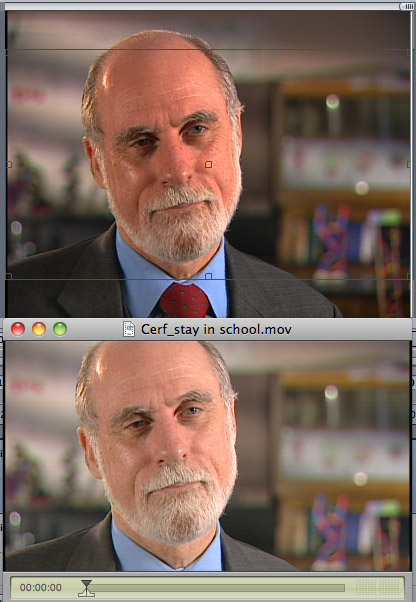
Here’s the finished result, the source image is on top, the scaled and cropped image is on the bottom. (For the rest of this article, I’ll work with the full image by adding padding, rather than cropping.)
THE FRAME CONTROLS INSPECTOR

Now that we have the size of the image set, we need to determine the quality of the image. For that, we go to the Frame Controls tab. Click the third button from the left (Frame Controls) to select the Frame Controls window.
The dark gear menu to the right of Frame Controls (at the bottom right of this screen shot) says that the settings are set to Automatic. Normally, this is OK.
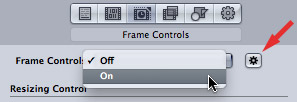
However, in this case, we want to explicitly turn on Frame Controls. So click the gear icon. This turns the automatic settings off. Then, select On from the popup menu.
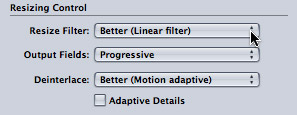
When you are up-resing an image, it is ALWAYS best to convert it to Progressive. The settings you need to change are:
NOTE: All standard-def video, both NTSC and PAL, is interlaced. There are rare exceptions for material shot 24 fps, but the safest thing to do is to assume that your material is interlaced.
As you experiment with up-resing your video – and you NEED to experiment, because different types of clips up-res differently – you can change either Resize Filter or Deinterlace to Best. However, DON’T change both to Best, because if you do, the underlying math is so complex that a process that might take an hour, stretches into DAYS!
In my tests, I could not see a significant difference in image quality between Better and Best. However, Best took twice as long to create a very similar result. I recommend using Better.
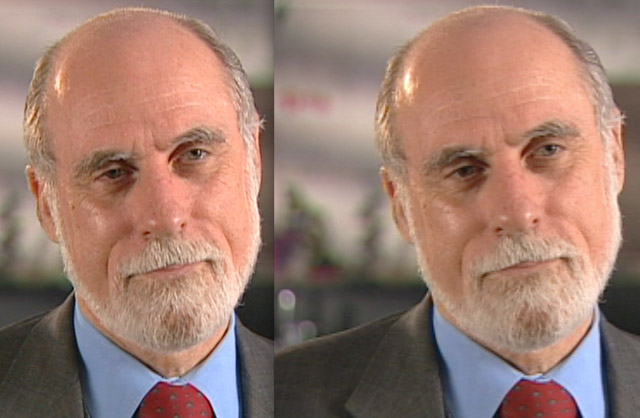
Here’s the final result. The up-scaled image is on the left, the original, enlarged image is on the right. Even when I reduced the size of these images for this article, there is a significant improvement in image quality when converting from SD to HD using Compressor — look at the detail in the beard, in the fabric of his coat, and the skin texture in the image on the left.
The difference is stunnngly apparent when viewed at full HD resolution. Frankly, if you care about quality, up-resing through Compressor is FAR superior to simply scaling your image in a video editor.
A NOTE ON CONVERTING FRAME RATES
Converting frame rates is far more difficult than up-resing an image. The basic rule of thumb is that it is better to go from a slower frame rate (24 fps) to a faster frame rate (30 fps), than to go from a faster frame rate to a slower frame rate. (Converting from faster to slower frame rates generally causes jerky movements, stuttering and other unpleasantness.)
The exception to this rule is converting from a frame rate (say 60 fps) into another frame rate that divides evenly into it (say 30 fps). So, 48 to 24, 50 to 25, and 60 to 30 are all frame rates that will convert smoothly.
For this reason, I tend to shoot all my material at 60 fps.
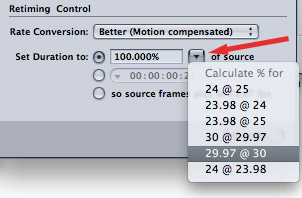
You can use Compressor for simple frame rate conversions, which are done by changing the speed of a clip. For frame rate conversions more complex than this, consider using a Teranex converter for material originating on video tape, or Amberfin software for file-based media.
SUMMARY
The downside to using software other than your editor to change the size of your images is that it takes time; sometimes, lots of time. The good news is that the time you spend is worth it.
Nothing beats shooting HD video in the first place for image quality. But, when you are working with historical footage, you don’t have a choice. Now you know what you can do to make your standard-definition images look as good as possible.
2,000 Video Training Titles
Edit smarter with Larry Jordan. Available in our store.
Access over 2,000 on-demand video editing courses. Become a member of our Video Training Library today!
Subscribe to Larry's FREE weekly newsletter and
save 10%
on your first purchase.
75 Responses to Compressor 4: Convert SD to HD
← Older Comments-
 stefan flos says:
stefan flos says:
December 17, 2018 at 1:54 am
-
 Larry says:
Larry says:
December 17, 2018 at 7:52 am
-
 Mark says:
Mark says:
March 4, 2021 at 11:17 am
-
 Larry says:
Larry says:
March 4, 2021 at 11:37 am
-
 Matthew says:
Matthew says:
March 28, 2021 at 12:56 am
-
 wes says:
wes says:
February 17, 2022 at 3:28 am
-
 Larry says:
Larry says:
February 17, 2022 at 7:00 am
-
 Sameer Thaver says:
Sameer Thaver says:
June 3, 2024 at 3:00 am
-
 Larry Jordan says:
Larry Jordan says:
June 3, 2024 at 3:54 am
← Older CommentsHi Larry
thanks for the explainer: tried it but I get blurred results. I see more than one frame blended into one so there is a lot of ‘motion blur’ even on still scenes.
But when i let fcpx do the job I don’t see any motion blur and when exported to a master file all is OK. I get clean images.
What am I doing wrong in motion that’s going right in fcpx by itself?
Stefan
Stefan:
Without seeing your settings, it’s hard to be sure what’s going on.
But, if you can get good results using FCP X, then, by all means use that.
Larry
Hi Larry – excellent information and still applicable today – thanks again. I (like others) am still editing/restoring old (personal) VHS and Hi8 (NTSC) videos that are currently compressed to 1394 DVstream (.dv files) from DV cameras. I purchased Compressor (4.5.x) recently with the goal of converting to these raw (.dv) stream files (480i) to either 720p or 1080p (at 29.97 fps) Pro Res 422 so I can edit them in the latest iMovie NLE. (Yes its technically best to keep the .dv files as interlaced (native resolution) throughout an editing workflow, however NLEs for editing in DV are gone with only few expensive/pro systems left) Note: current iMovie supports only your 540p, 720p, 1080p resolutions and frame rates (and I don’t need FCP for my limited amount of tapes/sources – so long story short I’m upsizing to be compatible with current iMovie NLE – but I keep the original .dv captures for archive).
One question I was really hoping you could clarify (which I’ve searched online forever and can’t get an answer on) is related to sequencing of operations in Compressor (or other tools). There is so much conflicting info out there. In other words, my issue revolves understanding how does Compressor handles an SD to HD transcode that may have multiple tasks to do vs the user doing a specific sequence of multiple lossless individual Pro Res transcodes (i.e., one task at a time). In addition, this/your article suggests that we could/should upsize, deinterlace, and pad all in ONE transcode. You also suggested in one of the comments herein that you should NOT deinterlace (separately) prior to upsizing because compressor is smart and uses (needs) the pixel information from both fields prior to upsizing. Other sites (not compressor) imply that you should always deinterlace prior to upsizing.
So my specific question is all related and is three fold: 1) Is compressor smart such that you can/should request/do ALL the multiple operations (you may want or need) in ONE single transcode (i.e., its smart and sequences all tasks properly to get the best result)? 2) Following this article, is it true the compressor actually upsizes using the individual fields data and THEN deinterlaces the larger image? How does compressor know to do this and how does the user know it does this? 3) If you chose to do individual transcodes instead, is it true that deinterlacing prior to upsizing would be worse than the other way around? Why? What is a the best sequence to upsize, deinterlace, pad, remove noise, adjust color, etc?
Thanks so much Larry – sorry for the excess detail.
Mark
Mark:
These are excellent questions and I don’t know the answer to one of them. Let me check with my sources and see what I can learn.
Larry
Thank you Larry! It never dawned upon me to up-convert my old FCP7 videos (created from DV sources) using Compressor first, and then importing into FCPX for tweaking. I now can update some old instructional videos and make them look a little more 21st century!
Matthew
if im using tape format and I want to convert from stand definition to digital lets say 1080×720. Do I need a converter like the blackmagic design teranex you once mentioned or can I just use blackmagic Ultrastudio capture device or will i need both?
Wes:
There are multiple issues here. First, standard definition video is only 720 x 480 pixels. Enlarging it to any form of HD will make it blurry.
Second, many video formats, especially VHS, have an unstable timebase which creates a shaky picture.
Third, most standard definition video is interlaced, which looks good on a TV, but terrible when posted to the web.
All this means that you need to process the video signal as well as record it. Whether you use a Teranex or something different, you will need something to make your images look good.
Larry
Hello Larry!
Its been quite a while….Anyhow, as you know I have a LOT of footage from formats as 3/4″, 3/4″SP, Beta SP + Of course…VHS & Mini DV which I had captured to Final Cut Pro 7 as QT Pro DV25 Format Files, would I be fine? Plus,what would some of the best possible software be for a Mac Pro on OS 10.8?…Naturally, I’d be aiming for
720 × 486
Sameer:
Yup, you got some older footage there. Quicktime DV25 should be fine – it was designed for those formats. As for software, no current video editing software will run on an operating system that old. So you are looking at legacy versions of Final Cut Pro 7 or Premiere Pro. Whichever you pick, the image quality will be fine – you just need to find software that runs on your system. If you don’t already own it, eBay is a good place to look.
Larry